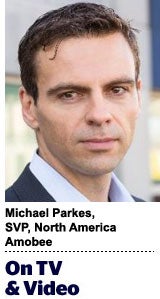 “On TV and Video” is a column exploring opportunities and challenges in programmatic TV and video.
“On TV and Video” is a column exploring opportunities and challenges in programmatic TV and video.
Today’s column is written by Michael Parkes, senior vice president, North America, at Amobee.
The consumer shift to spending more time on digital than on TV is pushing the industry toward a tipping point in advertising budget allocation.
Although advertising budgets will follow consumers’ attention, don’t expect TV to go away any time soon.
As a result, buyers need to make TV and digital budgets work together to ensure their dollars are spent wisely. There are still several barriers preventing effective cross-channel planning and buying that need attention, but TV and digital video buyers can also play a role in moving things forward so they can capitalize on the shifting media landscape.
Brand Safety
While many marketers have been vigilant about holding their partners to guaranteed brand safety measures, there is still a lot of work to do, particularly in mobile.
Mobile advertising fraud accounted for 12% of mobile ad spend in 2014, according to Solve Media. With mobile coming into its own, and rising fast, the fraudsters are hopping on board.
Companies like Integral Ad Science and DoubleVerify can provide brand safety across the mobile web and interstitial video, but are only dipping their toes into mobile in-app measurement due to the technical complexities.
Brand safety solutions need to be a top priority, especially in mobile.
Viewability And Audience Guarantees
AdExchanger Daily
Get our editors’ roundup delivered to your inbox every weekday.
Daily Roundup
Audience guarantees based on Nielsen OCR, now called Digital Ad Ratings (DAR), give advertisers a comparable buying metric to TV, yet, when combined with viewability guarantees, are still in their infancy.
Today, great progress is being made on desktop, pushing us one step closer to addressing buyers’ needs. In mobile, DAR is still being adopted, making audience and viewability guarantees more challenging to come by. Buyers need to know if their partners can provide this capability, which the industry at large will eventually need to support.
Deterministic Cross-Screen User Identification
Consumers have an average of three digital devices, so advertisers need accurate cross-screen measurement and targeting to achieve the reach and frequency they need to complement TV spend.
The problem with probabilistic solutions for cross-screen targeting and measurement is they may have high match rates, but only on a small proportion of their user base. Advertisers need to be able to buy the same users across screens at scale, with a one-to-one match rate, otherwise inefficiency will prevail and budgets will remain with TV while brands are overexposed to the same users.
There has been much activity in the space around creating a universal ID to accurately measure across screens. Facebook has a deterministic solution in Atlas, which leverages logged-in users, while Google also released cross-device measurement, but due to privacy concerns is using a probabilistic model. Other cross-device specific vendors, such as Drawbridge and Tapad, claim anywhere from 70% to 90% accuracy in matching devices.
Without high match rates there are a lot of inefficiencies for cross-screen buying. Digital frequency capping is the perfect complement to TV to increase reach in underrepresented demographics and manage frequency in overexposed audiences. The cross-screen match rate becomes an important factor in calculating video’s actual reach and frequency.
If video planners and buyers looked at their campaigns based on a cost per unique user, a deterministic match rate would improve efficiency dramatically. A 100% match rate (deterministic) is 30% more efficient than a 70% match rate (average probabilistic), saving money for advertisers by reducing wasted impressions.
Moving Forward With A New Mindset
These are not simple tasks, with decades of standard operating procedures in the way of changing industry standards. However, with the ever-evolving media landscape, brands, technology, standards and strategy must continue to adapt to drive efficient advertising campaigns that effectively reach the increasingly connected consumer.
The incremental opportunity offered to brands to gain efficiencies on the billions of dollars on TV spend cannot be ignored.
Follow Amobee (@amobee) and AdExchanger (@adexchanger) on Twitter.












